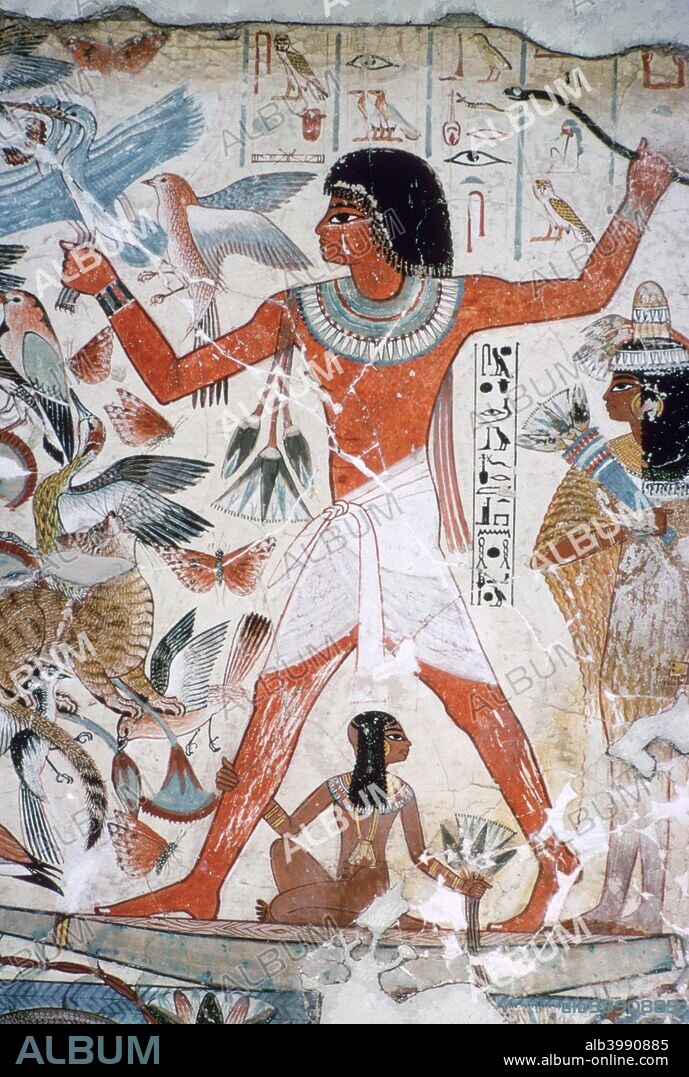alb3990885
Fowling in the marshes: wall painting from the tomb of Nebamun, Thebes, Egypt, c1350 BC. Artist: Unknown

|
Add to another lightbox |
|
Add to another lightbox |



Buy this image.
Select the use:

Title:
Fowling in the marshes: wall painting from the tomb of Nebamun, Thebes, Egypt, c1350 BC. Artist: Unknown
Caption:
Fowling in the marshes: fragment of wall painting from the tomb of Nebamun (no. 10), Thebes, Egypt, 18th Dynasty, c1350 BC. Nebamun stands on a small papyrus boat with his wife Hatshepset behind him and his son below. He is about to let fly a throwstick into a mass of birds above a papyrus thicket. The hieroglyphs below Nebamun's raised arm describe him as 'taking recreation and seeing what is good in the place of eternity', that is, in the Afterlife. There are at least two meanings to this scene. The spearing of the fish scene may allude to new life, as the tilapia fish is a symbol of rebirth. The other images may be subtly erotic, since the duck is known as an erotic symbol, and a woman dressed up, particularly with such a heavy wig, suggests some form of sexual association. From the British Museum's Collection.
Credit:
Album / CM Dixon / Heritage Images
Releases:
Model: No - Property: No
Rights questions?
Rights questions?
Image size:
3438 x 5111 px | 50.3 MB
Print size:
29.1 x 43.3 cm | 11.5 x 17.0 in (300 dpi)
Keywords:
18TH DYNASTY • AFTERLIFE • ANCIENT EGYPTIAN • AQUATIC LIFE • ARTEFACT • ARTFORM: FRESCO • ARTIFACT • AS SA'ID • BIRD • BIRDS • BOAT • BOATS • BRITISH MUSEUM • BURIAL • COLOR • COLOUR • CONCEPT • COUNTRY • DEATH • DUCK • DUCKS • EGYPT • EGYPTIAN • EROTIC • FEMALE • FISH • FOWLING • FRESCO • FRESH • GREECE • GUY • HIEROGLYPHIC • HIEROGLYPHICS • HUNTING • KARNAK • LADY • LOCATION • LUXOR • MALE • MAN • MARSHES • MARSHLAND • MAUSOLEUM • MEN • MURAL PAINTING • MURAL • MUSEUM • PAPYRUS • PEOPLE • PORTRAIT • POTRAIT • REBIRTH • SCRIBE • THÈBES • TILAPIA • TOMB • TRANSPORT • TRANSPORTATION • WALL PAINTING • WALLPAINTING • WATER TRANSPORT • WOMAN • WOMEN • WRITING
 Pinterest
Pinterest Twitter
Twitter Facebook
Facebook Copy link
Copy link Email
Email
